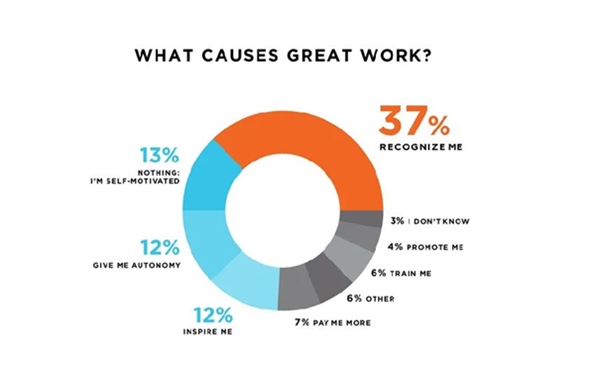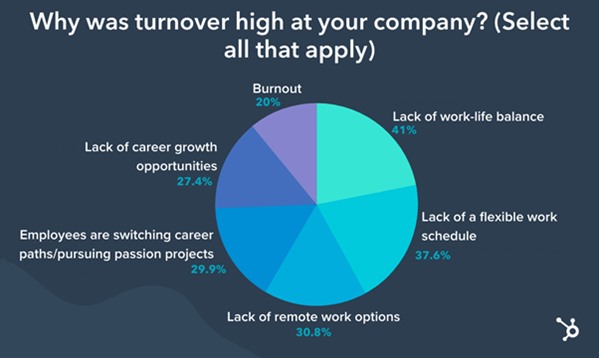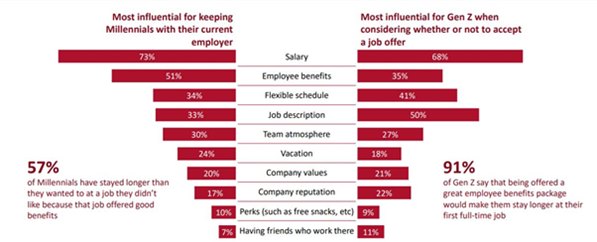
Employee turnover is one of the most wasteful yearly occurrences in any business. And in today’s world, it has become an increasingly recurring part of daily life.
An article by Forbes even called 2021 a “Turnover Tsunami” and given the data emerging from Vieser citing 1 in 4 Americans will quit their job by the end of 2021, it’s easy to see why. Data from the US Bureau of Labor agrees with this, claiming over 4 million people quit their jobs in April 2021 alone.
To an extent, employee turnover is perfectly natural. Employees come and go, things change, and sometime’s the fit just isn’t right. Still, the loss of employees is incredibly costly for a business. Time and money are required to train replacements that initially can’t provide the same output as experienced employees.
A LinkedIn article by Josh Bersin from Deloitte says that the cost of this can be anything from tens of thousands of dollars to almost double the employee’s annual salary. The Work Institute claims that the cost of employee turnover is more than 30% of the employee’s salary. Something the Employee Benefit News agrees with, citing 33% of a worker’s annual salary.
Either way, this is a worrying statistic. As the United States goes through what is being called the Great Resignation ( The Achievers Employee Engagement and Retention Report claims over 52% of workers sought new jobs in 2021 alone), employee turnover is well worth reducing.
7 Easy Ways to Reduce Employee Turnover
Employee turnover is not just an irritation for employers, it can and does add up to a waste financially. Given the frequency of Millenials and Gen Z changing jobs, it is becoming an increasing priority.
To help your company retain its increasingly valuable employees, read on for 7 Ways to Reduce Employee Turnover.
1. Hire Smart
Choosing the right people for the job is probably the most important aspect of reducing employee turnover. If you choose to employ people who don’t fit your company culture or dynamics, not only will they be unhappy and likely to leave, but you’ll have wasted your time and theirs trying to fit a round peg into a square hole.
Data-driven recruitment helps you hire the best people for precisely that reason. Taking a holistic and analytic approach to hiring, it can cut down on hiring costs, up experiences with prospective employees, and overall improve the quality pool from which you hire. It can also help your recruiters cut down or at least better direct HR when they make hiring decisions “from the gut”.
While experience and qualifications are important, they’re not the only things that matter. There’s a lot to be said for focusing on soft skills and hiring smart, versatile people with innate talent that can fit into various roles in your business.
Employees who have the same values and goals as your company are crucial. Not only do they immediately fit in, feel attached to, and want the best for the company but they actively contribute to good and healthy work culture.
2. Reward and Recognize
Recognition and rewarding hard work are two of an employer’s largest tools when it comes to reducing employee turnover.
Recognizing employee efforts frequently ranks as a crucial component of what matters to employees.

Undervalued employees can quickly become bitter and unhappy whenever they feel their work has gone unnoticed. A survey by Globoforce and SHRM reported that 90% of employees reported feeling more satisfied with their work when rewarded with peer-to-peer recognition.
Rewarding employees can take many forms whether this is financial in terms of bonuses or outings, additional time off, gifts, or some sort of personal incentive based on something unique you know that employee will appreciate.
One of the more unique ways to reward your employees is donation matching. This is a type of donation where a business matches employee donations to nonprofits and charities. This is a great way to reward an employee while rewarding great causes in the community – especially if you offer to double or triple that employee’s contribution!
3. Promote work-life balance
Balancing the work-life boundary is becoming an increasingly important factor for employees.
Traditionally, work can be an all-encompassing facet of life. Whether that’s a result of grind culture due to low wages, poor management, incessant emails, and the insistence that one be available nearly 24/7 should issue at work arise. The desire to succeed or not be seen as a bad employee can often exacerbate these issues.
The idea that you should live to work rather than work to live is proving to be a quickly antiquated notion. Millennials and Gen Z, more than ever, are choosing to prioritize their work-life balance and will often leave a job rather than compromise on their leisure time. Research from Hubspot corroborates.

If your employees feel they are living to work, rather than working to live, there’s a major possibility you’ll experience employee turnover.
4. Offer a comprehensive competitive benefits package
It should go without saying that employers that offer competitive salaries lead to happier employees. That in turn reduces employee turnover as happy employees stay.
One component that cannot be ignored is having equally competitive benefits packages. And that’s not just avocado toast or ping pong tables.
Between the 2008 Recession and COVID 19, Millennials and Gen Z employees are increasingly financially aware and are looking to find companies that can offer them robust benefits.
A study by the Lincoln Financial Group backs this up. According to that study, 57% of Millenials say that they’ve stayed at a job they didn’t like because of the benefits package. 93% of Gen Z say that being offered a great benefits package would make them stay longer at their first full-time job.

Here are a few things for employers to focus on when creating their benefits packages:
- Health Insurance
- 401K Pans with accompanying benefits
- Paid Time Off
- Dental Insurance
- Financial Counseling
- Tuition Support
5. Show your respect
“Respect is a two-way street.”
We’ve all heard it before. What’s often forgotten is that one of those lanes comes from the direction of management. Shouting, screaming and unrealistic demands can create a corrosive atmosphere and one that’s almost impossible to recover from.
Mutual respect is just good management. Employees will work harder for managers for who they feel respect and obligation toward. That inherent sense of trust, mutual collaboration, commitment, and a good work atmosphere is crucial in any work environment.
A few basic points to remember that might help both parties with this includes:
- Treat people the way you’d want to be treated
- Remain calm and keep it professional
- Learn the difference between constructive and corrosive criticism
- Keep an open mind and attitude toward other’s ideas
- Make employees feel valued, heard, and seen.
- Communicate, communicate and communicate.
In addition to the above, providing a clean working environment for your employees by having a reputable cleaning company clean your offices regularly is also highly recommended. It will not only help improve your employee’s well-being but can also result in improved overall productivity.
Ultimately this will lead to increased rates of retention for employees.
6. Offer flexible work schedules
With remote work coming to the forefront of society since COVID 19 became a global pandemic, it’s safe to say remote work is here to stay.
While it may have been initially seen as a temporary measure, more and more companies are offering hybrid work options as well as fully remote jobs. Adobe, Amazon, Facebook, and Hubspot are just a few of the world’s top companies looking at going either fully remote or increasingly hybrid. In fact, according to Future Workforce Report, 32 million Americans will be working remotely by 2025.
That’s no surprise given the benefits attached to remote work. Increased productivity, schedule flexibility, reduced costs of commute and the near erasure of unnecessary meetings are all almost immediate benefits of remote work.
Glassdoors Economic Research Report confirms that job seekers in today’s economy are increasingly interested in remote jobs. According to their research, searches for remote positions increased by 360% from June 2019 to June 2021.
Employers need to not only take into account these trends but figure out the best way to go about recruiting and structuring their remote teams to fully benefit from this.
7. Develop a robust Onboarding process
The onboarding process in a company is an often overlooked part of what goes into not only settling in new employees but making sure that these employees settle in well.
Good onboarding can make an employee feel welcome, informed, and aware of the workplace culture and values and make them feel at ease in their new environment. This translates into loyalty which then leads to lower rates of employee turnover. A recent report found that 69% of employees are more likely to stay with their company for at least 3 years if they’ve had a great onboarding process.
Onboarding is a company’s first opportunity to make a good impression. If it seems like the culture of the company isn’t quite right, employees will quickly start seeking new opportunities.
Bad onboarding looks something like dropping a new employee in the office with no clue and leaving them to find their way around. Good onboarding, on the other hand, involves mentor pairing, introductions, explanation of tools as well as regular checking in and providing support.
As obvious as it sounds, bad onboarding is a mistake a lot of managers make that could have you having to find new hires sooner rather than later.
Final Thoughts
With Millenials and Gen Z increasingly choosing to prioritize their health and happiness over pay or job security, employees are experiencing increased employee turnover. As the US and indeed the world, experience the “Great Resignation” keeping the employees you have is crucial to a successful business.
Between the loss of productivity as new hires acquire skills your old employees already had, the waste of time training these replacements, and the actual cost of recruiting, interviewing, and hiring new employees, employee turnover can have a greater impact on your business than you expected.
While it may sound like doom and gloom, the truth is quite the opposite. Reducing employee turnover is a lot simpler than it seems. Oftentimes, all it takes is a few conscious and purposeful tweaks to your company policy. Whether it’s increasing your flexibility with employees working from home, offering comprehensive benefits packages or even just being more respectful towards your employees.
These qualities will reduce your employee turnover as well as make you a good “People Company” which will allow you to not just become more productive but more successful. The truth is that the more you value your employees and show them that, the more likely they’ll want to remain and grow with your company.
And that’s just good business.





As you mentioned we are entering a time where millennials and Gen Z are putting their needs above that of work, which is great, but this means that employers are now the ones who need to work hard to keep their employees engaged. Job security is not enough anymore!